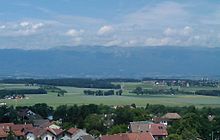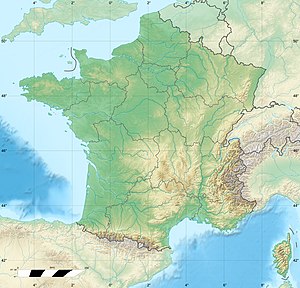| Battle of Saint-Julien (1814) | |||||||
|---|---|---|---|---|---|---|---|
| Part of the Campaign of France of the Sixth Coalition | |||||||
 The Jura Mountains can be seen from Saint-Julien. | |||||||
| |||||||
| Belligerents | |||||||
|
|
| ||||||
| Commanders and leaders | |||||||
|
|
| ||||||
| Strength | |||||||
|
4,800–11,000[1] 13 guns |
5,600–6,000[1] 29 guns | ||||||
| Casualties and losses | |||||||
|
1,300[1] killed, wounded, or captured 5 guns lost | 650[1] killed, wounded, or captured | ||||||
Location within France | |||||||
The Battle of Saint-Julien (1 March 1814) saw Imperial French troops led by Jean Gabriel Marchand attack Austrian soldiers under Johann Nepomuk von Klebelsberg. In tough fighting, the Austrians managed to hold off persistent French assaults during this War of the Sixth Coalition clash. The next day, the Austrians withdrew within the defenses of Geneva, a distance of 9 kilometres (6 mi) to the northeast. The battle was part of operations in which a French army led by Marshal Pierre Augereau squared off against Austrian forces under Ferdinand, Graf Bubna von Littitz.
The 1814 Campaign in Northeast France pitted Emperor Napoleon against the main Allied armies of Field Marshals Karl Philipp, Prince of Schwarzenberg and Gebhard Leberecht von Blücher to the east of Paris. Meanwhile, a lesser campaign was fought around Lyon and Geneva to the south. In January 1814 the Austrians seized Geneva and occupied vast tracts of eastern France, but they failed to capture Lyon. In mid-February, Pierre Augereau launched an offensive from Lyon toward the north to recapture territory. On his extreme right flank, Marchand's division recaptured parts of Savoie and advanced to the gates of Geneva, which was an important Austrian base. Alarmed for the safety of his supply line to Germany, Schwarzenberg quickly dispatched massive forces to guard his southern flank.

